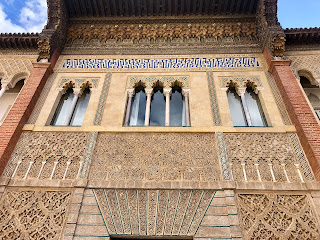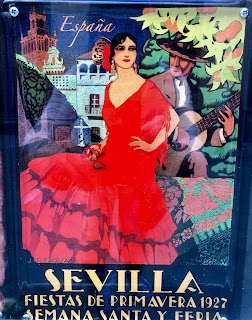Andalucia, Spain: Sevilla and Granada
The dry plains of Andalucia reminded me of New Mexico where I grew up. I could imagine how recognizable this semi-desert terrain felt to the Spanish conquistadors from Seville and Granada when finding themselves far away from their homeland across a vast ocean, they were comforted by a familiarity in their new surroundings: plains dotted with agave, yucca and cactus, mountains shimmering off in the distance and a life-sustaining river guiding them North.
As they made their way across the deserts of Mexico up into the Rio Grande valley these stalwart adventurers were driven by Glory, God and Gold. Their greed inflamed them and their passion kept drawing them farther and farther afield in search of the magical, mythical city of Cibola where their superhuman efforts would be rewarded on this earth.
The legion of padres that accompanied the Conquistadors were on a new Crusade to convert the resident savages to Christianity. Both conquistadors and missionaries were aglow with the recent Christian triumphs over the opposing Moorish Islamic faith that had so just been scourged from their homeland by their Catholic monarchs Ferdinand and Isabel. After seven centuries of rule in what is today southern Spain, the Moors were driven back to their African homeland.
It is the modern-day Spanish cities of Seville and Granada that we explored on this trip. Andalucia embodies the ancient struggle between Christian and Islamic faiths. The differences are reflected in their history, culture, art, architecture, people, and lifestyle. Yet today one finds a melding of both these divergent world views lives deeply rooted in the soul of the people.
As elsewhere throughout the world the practice of superimposition, layering and building your iconic religious monuments atop those of the vanquished, is what makes the architecture here so rich.
 |
| Great Christian Cathedral in Sevilla |
 |
| Ghirlada Tower left by the Islamic Moors |
 |
| Bells in the Ghirlada Tower |
Thus we have the classic religious superimposition at the great Cathedral in Sevilla where Ferdinand and Isabelle held court and conquered in the name of Christianity. When the Moors were pushed out of Spain the church started building a monument to their victory and Christian religious glory in the great Cathedral right on top of the previous Moorish mosque. As the Giralda Tower was the tower the Islamic musseins did their high pitched entreaty several times a day calling the faithful to prayer. The musseins built the tower so they could ride a mule up the circular tower path to the top. The Catholic Church decided to leave the Ghirlada Tower an exquisite piece of architecture, a monumental 25 story structure and use it as the Cathedral's bell tower. So you have the fusion of Christian and Islamic faith at the great Catedral in Sevilla.
 |
| Geometric crosses in part of the gold ceiling in the Cathedral |
Because the original art is often incorporated into the newer building you see this rich intertwining of cultures. Yet two more divergent art and architectural styles would be hard to find. The icon rich cathedrals and churches of Christianity are gilded with the riches of the gold mined in the Spanish colonies. Saints and the visages of Jesus, Mary and the Holy Family are draped in gold and embued with a depth of suffering that is of this world and can only be relieved by the safe passage to heaven in the world beyond. Heaven forbid you fail to live a Christian life and perish forever in the fires of hell or perhaps get stuck in limbo for eternity.
 |
| Gold covered altar of the Cathedral |
 |
| Saints deified in gold |
 |
| Sevilla Cathedral Main Altar |
 |
| One of the towers that protected the Guadalquivir River in Seville where gold was stored. |
 |
| Santa Maria prototype of ship Columbus sailed on. These were SMALL ships. |
 |
| One of many Gold Crowns encrusted with gems |
 |
| Cathedral Gardens from the top of the Giralda Tower |
The Islamic art of the Moors is as devoid of icons as Christianity is rich with them. Islam art and architecture features script from the Koran and the mesmerizing designs of repeated patterns that draw the eye, soothe the mind and lift the soul. Symmetry and geometric designs are taken to artistic heights unparalleled.
 The Alcazar is the Moorish Fortress built near the Cathedral in Sevilla that was the home of the Moorish King until Ferdinand and Isabel dispelled him in their 1492 conquest. The beautiful and rich detail of the carved marble and sandstone is jawdropping.
The Alcazar is the Moorish Fortress built near the Cathedral in Sevilla that was the home of the Moorish King until Ferdinand and Isabel dispelled him in their 1492 conquest. The beautiful and rich detail of the carved marble and sandstone is jawdropping.
The courtyards consist of one royal arch after another and exquisite geometric and repeating patterns. The enclosed courtyards are created with peaceful gardens and water features.

My favorite photograph from the Alcazar was taken in the underground pools that the Moors used for bathing. The women could go to these baths and not be bothered or exposed to men. They had a rigorous schedule when men and women could bathe and luxuriate in the peaceful environs.
THE ALHAMBRA
Washington Irving was one of the first American to go to Granada and live in the sequestered town quarters of the Alhambra during the 1800s. Thus his writing of the book The Alhambra. The town sits atop a town of tradesmen and villagers and was built as a Moorish fortress to show the power and presence of the rulers and their Islamic faith. The artwork within is truly spectacular and speaks to the artistry of the Islamic craftsmen and artists.
 |
| Exquisite carvings in marble and plaster adorn the ceilings and walls of the Alhambra |
 |
| Symmetrical Gardens and fountains offer respite from the heat |
The Alhambra is truly an impressive city and fortress within high impregnable walls. It includes the amazing Palace of the Nazrids (the Emir's house), beautiful symmetrical gardens, villagers/caretakers' homes and all the resources needed in case it was necessary to close it off from attackers.
Thus it is hard to imagine that Isabel and Ferdinand's troops successfully evicted the resident Moorish Emir finally in January 1492. Internal fighting and lack of leadership from the new emir Boabdil weakened the Moors. Boabdil had once been a vassal of Ferdinand and Isabel's (trying to play both sides) until he could no longer do so. The Christian victory called the Reconquista ended this 10-year war with the desperate Moorish emirs economically strangulating the local Granadans with taxes and the dominance of advanced Spanish bombards and cannon artillery. Queen Isabella of Castile was the source of most of the funds and artillery and Ferdinand of Aragon contributed warships as well as some funds. She clearly dominated in this conquest and visited the battlefields often supporting the troops. This victory cemented the Ferdinand and Isabel union and combined the Castile and Aragon regions under their kingship.
This Catholic victory and expulsion of the Moors joined the regions of Castile (Isabel) and Granada
(Ferdinand) and most of southern Andalusia. It serendipitously occurred just in time to have Isabel and Ferdinand no longer involved in an expensive war so they could take a financial bet on an Italian Christopher Columbus.
Columbus proposed to find a Western route to the Indies. The Queen and King turned him down the first time but after some of their advisors convinced them that they had little to lose and a lot to gain they agreed to his journey. The details are set forth in their agreement the Capitulation of Santa Fe which allowed that Italian Columbus would sail under the title of Admiral of the Sea in the name of Spain. It further stipulated he was to be granted one-tenth of the riches from the explorations. Columbus' tomb in the Cathedral in Sevilla, as well as the Carrara marble tombs of Ferdinand and Isabel in a chapel next to the great Cathedral in Granada are huge tourist attractions.
Their bet paid off in untold riches and plunder from the discovery of the West Indies and later the bloody Spanish conquest of much of South America. The riches of plundered gold poured into the Towers of Sevilla where Ferdinand and Isabel held court. Sevilla was chosen as a strategic location to hold the riches of the New World. It was not on the Atlantic coastline which would leave it open to marauders, but was further inland and could be defended by two towers built with a heavy chain that linked them. The chain could be pulled up to deter admittance of any ships to the city and the riches held there could more easily be defended.
 |
| Gold Ceiling of the Cathedral in Seville |
  |
| One of the Towers protecting Sevilla and the riches stored there still stands. |
Bodegas and Bull Fights
While we did not see any bullfights when in Spain, we were regular frequenters of their many bodegas ( bars and restaurants). We were there long enough to develop some favorites and even be recognized by the camareros (waiters) and bartenders. The wonderful energy of the neighborhood bodega and its bar and restaurant with seating usually both outside and inside make them the social center of every hood in Spain. They are places to enjoy the conviviality of friendship or just hang out and while away part of the day/night.
The waiters are professionals and proudly serve both local regulars and the abundance of tourists who frequent these leisurely hangouts. We had a favorite bodega just at the top of our street where our AirBnb was and made it a habit to get there daily. Of course wine/beer is served instead of water and it is always accompanied by tapas, the small appetizer size plates Andalucia is famous four.
 |
| Famous fighting bulls decorate the walls of a favorite bodega |
 |
| Bar Estrella Restaurant at the end of our street in old Sevill |
 |
| Making friends with the waiters and bartenders |
 |
| The bullring was empty so why not? |

 |
| The Tommie Tippy cup took a tour of Sevilla |

Flamenco
It would not have been a visit to southern Spain without enjoying the beauty of the Flamenco dance which embodies the heritage of joy, angst, rhythm, music, sweat, sensuous flirtation and color that typifies the history of these peoples. Put yourself here as a young romantic in search of love or even as a woman caring for a passel of children, a laborer in the fields or just some local trying to make a living and feed the family. All appreciated this vigorous and sensual dance of the paisanos.
The depth of feeling that the Flamenco dancers both men and women portray in their rhythmic dance is powerful and the voices that sing the music are both sorrow-filled and resonantly joyful in turn. I enjoyed the Flamenco as the true musical and dance heritage of this amazing country. It takes years of practice and dedication and the dancers and musicians become life long friends in their pursuit of this passion. The dancers at the Flamenco performance we saw, also stopped at the local Bar Estrella before their performances so one got a feeling of how Flamenco is woven into the fabric of their lives: Work, dance, eat, drink, play, enjoy friends and do it all over again. We should take their lead on this.
























